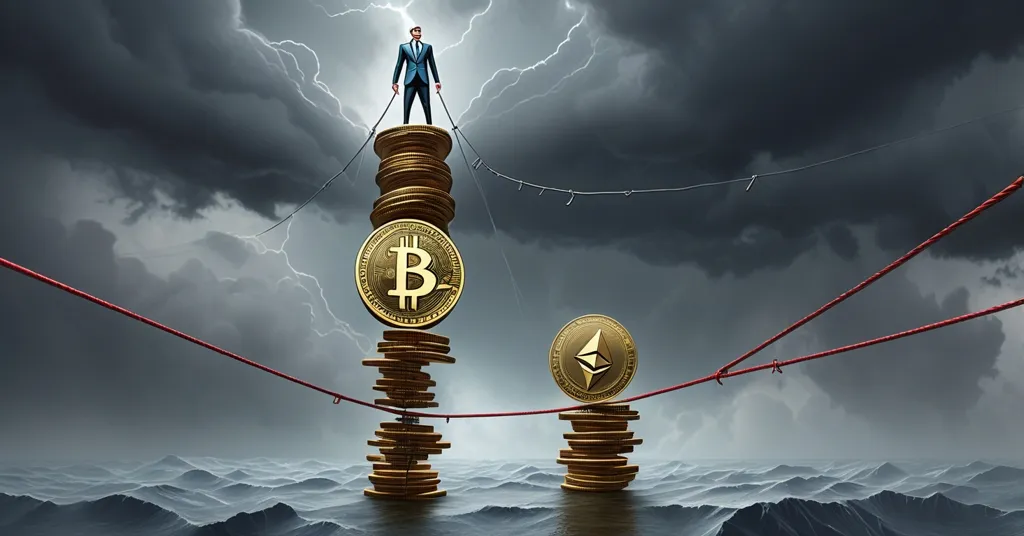SharpLink’s $3.2B Ethereum Bet: Survival Amid $103M Loss and ETH Volatility?

Ethereum Price Prediction: Can SharpLink’s $3.2B ETH Bet Survive a Devastating Revenue Crash?
SharpLink Gaming (SBET) is placing a colossal $3.2 billion wager on Ethereum (ETH), holding 728,804 tokens while grappling with a crippling $103.4 million quarterly loss. With Ethereum’s price hovering around $4,457 and market volatility biting hard, we’re breaking down whether this crypto treasury gamble can rescue a 30% revenue plunge or if it’s a reckless dive into financial quicksand.
- SharpLink’s Financial Abyss: A $103.4M net loss, fueled by an $87.8M non-cash impairment on ETH holdings, with Q2 2025 revenue tanking 30% to $0.7M.
- Ethereum Treasury Play: $3.2B in ETH reserves and 1,326 ETH in staking rewards signal long-term optimism despite brutal short-term hits.
- ETH Market Dynamics: Price dips 2% to $4,457; technicals suggest bullish potential if support at $4,350 holds, but risks loom large.
SharpLink’s High-Stakes Ethereum Gamble
SharpLink Gaming isn’t just dipping its toes into cryptocurrency; it’s cannonballing into the deep end with a staggering 728,804 ETH, valued at over $3.2 billion. This hoard, amassed through $2.6 billion in offerings, represents a bold pivot to an Ethereum-focused treasury strategy. But the numbers tell a grim tale: a quarterly net loss of $103.4 million, driven largely by an $87.8 million non-cash impairment on its staked ETH holdings, as detailed in their latest financial filings. Under U.S. GAAP accounting rules, companies must report lower values for volatile assets like ETH during price dips—marked down as low as $2,300 per token in this period—even if they haven’t sold a single coin. Think of it as writing down your car’s value on paper because the market softened, except this “car” is worth billions and the write-down spooks shareholders. The result? SharpLink’s stock cratered 15% to $19.85 post-announcement.
To make matters worse, operational performance is in freefall. Revenue for Q2 2025 dropped 30% year-over-year to a pitiful $0.7 million from $1.0 million, with gross profit limping along at $0.2 million. Yet, SharpLink isn’t waving the white flag. Since June, they’ve been staking ETH—locking tokens to secure the Ethereum network and earn rewards—netting 1,326 ETH. For those new to the space, staking emerged after Ethereum’s 2022 “Merge” to Proof-of-Stake, a mechanism where holders validate transactions instead of energy-hungry miners. Yields typically range from 3-5% annually, per StakingRewards.com data, offering a trickle of income but nowhere near enough to offset a nine-figure deficit. Is this a lifeline or just a Band-Aid on a gaping wound?
Leadership’s Bold Bet Amid Red Flags
Despite the financial carnage, SharpLink’s leadership exudes confidence. Co-CEO Joseph Chalom, a former BlackRock executive, stands firm on their approach, as outlined on their official company site.
“The firm had scaled its ETH position ‘in a highly accretive manner.’”
In plain terms, they’re saying they’ve bought ETH at prices that could look like a bargain in the future. Adding weight to this vision, Ethereum co-founder Joseph Lubin joined as chairman, bringing heavyweight credibility. A partnership with Consensys, a titan in Ethereum infrastructure, further cements their commitment, though it came with a hefty $16.4 million in stock-based compensation for advisory services. Let’s not sugarcoat it: shelling out that kind of equity while revenue collapses is a bitter pill for shareholders already rattled by losses. Are these moves a sign of strategic genius or a desperate grab for relevance in the crypto sphere?
Ethereum’s Utility: Why SharpLink Chose ETH
SharpLink’s strategy draws inspiration from MicroStrategy’s Bitcoin playbook—stacking crypto as a balance sheet asset for long-term gains—but Ethereum offers a different flavor of potential. Unlike Bitcoin, often dubbed digital gold for its scarcity and simplicity, ETH powers a sprawling ecosystem through smart contracts. For the uninitiated, smart contracts are like digital vending machines: input the terms, and they execute automatically without middlemen, enabling everything from loans to art sales. Ethereum hosts over 60% of decentralized finance (DeFi) total value locked, per DefiLlama, and dominates non-fungible tokens (NFTs), digital collectibles that exploded in popularity. Recent upgrades like the Dencun update slashed transaction costs on Layer 2 networks (think side roads easing highway traffic), potentially turbocharging adoption. For SharpLink, betting on ETH isn’t just about price appreciation; it’s about banking on a platform that underpins much of blockchain’s innovation, as explored in discussions around their $3.2B Ethereum wager.
But here’s the harsh reality: crypto volatility can erase paper gains in a heartbeat. Ethereum’s price swings directly impact SharpLink’s perceived treasury value by billions. Plus, regulatory murkiness—especially the SEC’s vague stance on crypto accounting—means more impairments could be on the horizon. Under current U.S. GAAP rules, holding volatile assets is a double-edged sword, punishing firms with markdowns even during temporary dips. And if the SEC or Congress tightens the screws with stricter tax or reporting laws, SharpLink could be left holding a multi-billion-dollar hot potato. This isn’t just market risk; it’s a systemic gamble on a financial framework that’s still playing catch-up with blockchain reality, with some questioning if their Ethereum treasury approach is too risky.
Ethereum Market Analysis: Bullish Flickers or False Hope?
While SharpLink’s books bleed, their Ethereum hoard’s fate hinges on broader market currents. ETH recently slipped 2% to $4,457, with $169 million in futures liquidations over 24 hours—a brutal reminder of leveraged traders getting torched. For newcomers, liquidations occur when over-borrowed positions are forcibly closed due to price swings, essentially wiping out speculators betting on margin. On the charts, ETH trades near $4,405 within an ascending channel, a pattern hinting at upward momentum if key levels hold. Support sits at $4,350–$4,400, with a deeper floor at $4,170. Resistance looms at $4,785, with a psychological barrier at $5,000. Technical indicators like the Relative Strength Index (RSI) at 44 show neither overbought nor oversold conditions, leaving room for a bounce—or a bust, as analyzed in a recent Ethereum price outlook.
Beyond charts, on-chain data adds context. Ethereum’s active addresses remain robust, per Glassnode metrics, signaling steady user engagement, while gas fees have moderated post-Dencun, potentially spurring DeFi and NFT activity. For SharpLink, every dollar ETH climbs or falls translates to massive swings in their balance sheet’s perceived worth. If ETH holds $4,350 and pushes toward $5,000, their strategy might gain traction with investors. Crack $4,170, though, and the pain could deepen—both for their treasury and shareholder sentiment. It’s a high-wire act with no safety net.
Risks of Crypto Treasuries: A Cautionary Tale?
SharpLink’s approach isn’t uncharted territory. MicroStrategy’s Bitcoin accumulation since 2020 boosted its stock during bull runs, inspiring others to view crypto as a reserve asset. But not every corporate crypto bet pays off—firms caught in the 2022 bear market faced savage impairments, with some never recovering investor trust. SharpLink’s ETH focus adds a twist with staking yields, but the core risk remains: volatility. A single black swan event—be it a market crash or regulatory clampdown—could obliterate paper gains. And let’s be real: while Ethereum’s utility in DeFi and NFTs is unmatched, Bitcoin’s singular focus as digital gold might make it a less chaotic treasury choice. Did SharpLink back the wrong horse by ignoring BTC’s simplicity? This concern is echoed in analyses of Ethereum staking impacts on corporate treasuries.
Then there’s the broader crypto landscape’s speculative fever. Projects like Bitcoin Hyper ($HYPER), a Bitcoin-native Layer 2 solution using the Solana Virtual Machine for fast, cheap smart contracts, raised $9.7 million in presale at $0.012725 per token. It’s pitched as merging Bitcoin’s security with Solana’s speed, but it’s also a reminder of how quickly attention shifts, as discussed in community reviews of Bitcoin Hyper’s presale. Ethereum dominates Layer 2 scaling with networks like Arbitrum and Optimism, yet Bitcoin’s ecosystem is catching up. If $HYPER or similar innovations pull developers away, ETH’s dominance could face indirect pressure. More broadly, the space is riddled with cautionary tales—unrelated presales like Anso Finance ended in rugpulls, and others like Lightchain AI hit delays despite millions raised. SharpLink’s ETH bet might be safer than a speculative token, but the market’s wild west vibe underscores the gamble they’re taking.
What’s Next for SharpLink and Ethereum?
SharpLink is playing a dangerous game, banking on Ethereum’s long-term ascent while hemorrhaging in the here and now. Their leadership’s pedigree and Consensys ties are impressive, but a $103.4 million loss—even if mostly on paper—stings like hell. Ethereum shows flickers of bullish potential if support holds, but volatility and liquidations keep the waters choppy. Regulatory risks loom large, potentially turning their $3.2 billion stash into a liability overnight. Meanwhile, innovations like Bitcoin Hyper hint at a fiercely competitive future where even giants like ETH must fight for relevance, as noted in a detailed report on SharpLink’s crypto treasury strategy.
Looking ahead, key catalysts could sway the outcome. SharpLink’s next earnings will reveal if staking rewards or ETH price gains can soften the blow. For Ethereum, developments like spot ETF approvals or further upgrades could drive momentum—or regulatory setbacks could tank sentiment. For everyday ETH holders and retail investors, SharpLink’s experiment might signal whether crypto treasuries are the next big thing or a stark warning of overexposure. Will this be a visionary masterstroke or a spectacular faceplant that leaves investors burned? Only the market’s relentless churn will tell.
Key Questions and Takeaways on SharpLink and Ethereum’s Trajectory
- Can SharpLink’s $3.2 billion ETH holdings balance out a $103.4 million loss?
Not immediately—revenue’s down 30% to $0.7 million, and non-cash impairments are hammering confidence. A sustained ETH rally could shift the story, but only if they weather the storm long enough. - Is Ethereum’s price dip a chance to buy or a danger signal for SharpLink?
At $4,457 with support at $4,350, it could be a buying opportunity if technicals hold. But a break below $4,170 might worsen SharpLink’s already battered balance sheet. - How risky is SharpLink’s crypto treasury compared to traditional investments?
Incredibly risky—volatility and accounting rules trigger losses without selling, unlike stable assets. A 15% stock drop shows investors are wary of this high-stakes play. - What’s the role of Ethereum staking in SharpLink’s strategy?
Staking earned 1,326 ETH, providing a 3-5% yield to offset price drops, but it’s a tiny buffer against massive impairments and doesn’t tackle core revenue issues. - Do projects like Bitcoin Hyper challenge Ethereum’s dominance and SharpLink’s bet?
To an extent—$HYPER’s $9.7 million presale shows Bitcoin’s ecosystem scaling up, but Ethereum’s DeFi and NFT stronghold keeps it ahead for now. Competition, though, is heating up.



